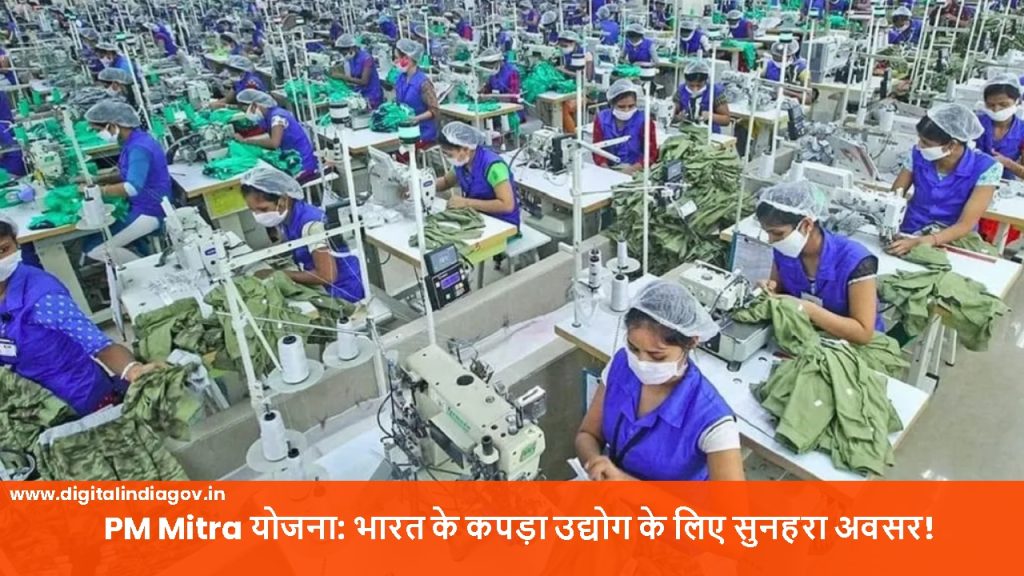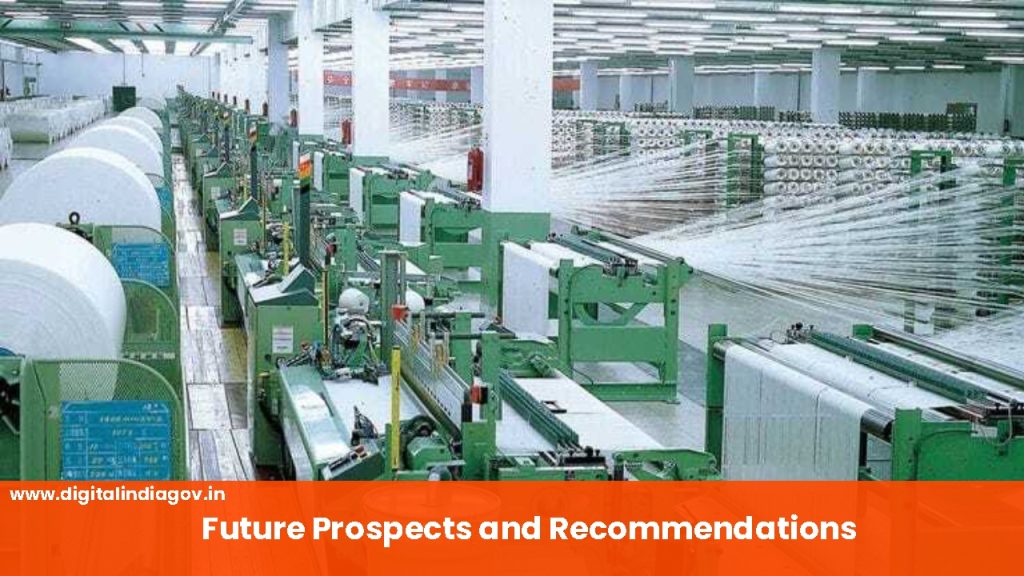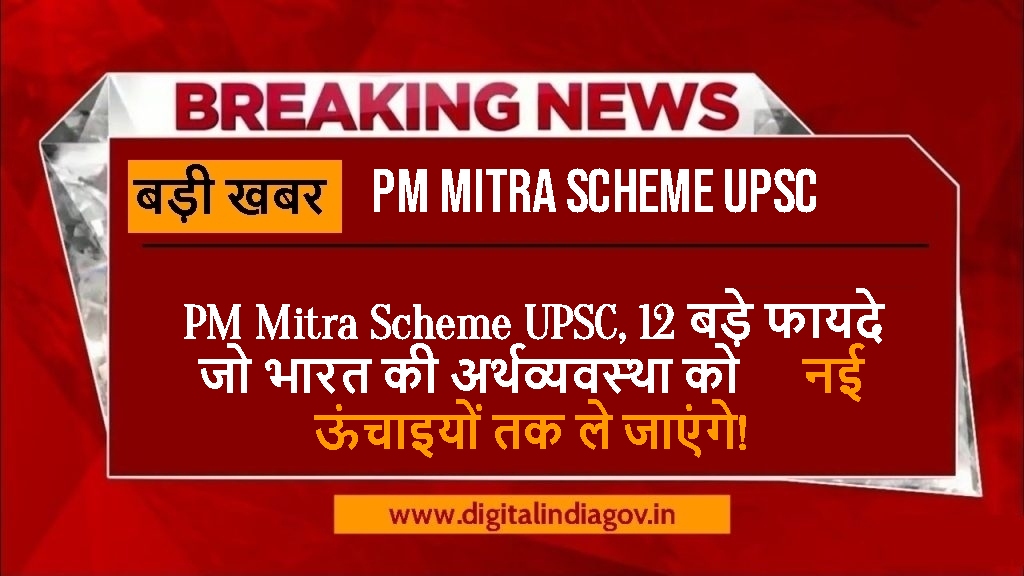PM Mitra Scheme UPSC, भारत सरकार ने पीएम मित्र योजना (प्रधानमंत्री मेगा एकीकृत वस्त्र क्षेत्र और परिधान योजना) के साथ कपड़ा उद्योग को बढ़ावा देने के लिए एक बड़ा कदम उठाया है। अक्टूबर 2021 में शुरू किए गए इस कार्यक्रम का उद्देश्य निर्यात बढ़ाना, रोजगार सृजित करना और भारत की कपड़ा विनिर्माण क्षमता को मजबूत करना है। यूपीएससी आवेदकों के लिए इस कार्यक्रम को समझना आवश्यक है क्योंकि यह सरकारी कार्यक्रमों, औद्योगिक रणनीति और आर्थिक विकास से संबंधित है, जो इसे प्रारंभिक, मुख्य और साक्षात्कार चरणों के लिए एक प्रासंगिक विषय बनाता है।
Contents
Objectives of PM MITRA Scheme(पीएम मित्र योजना के उद्देश्य)
The PM MITRA Scheme’s main goals are as follows:
- Building top-notch infrastructure for textile production and value chain integration will strengthen the textile industry.
- Increasing Competitiveness: Using interconnected industrial parks to lower logistical costs and attract investment.
- Employment Generation: Encouraging both direct and indirect employment in the clothing and textile industry.
- Attracting FDI: Bringing in both domestic and foreign investments to turn India into a global center for textile production.
- Innovation and Sustainability: Promoting technologically advanced and environmentally friendly textile manufacturing.
- Self-Reliance (Atmanirbhar Bharat): Increasing domestic industrial capacity to lessen reliance on imports.
- Export Promotion: Improving India’s standing in the world market for textile exports and cutting trade imbalances.
- Supply Chain Optimization: To increase productivity and cost-effectiveness, a smooth, end-to-end textile value chain should be established in India.
Also Read: PM Pension Scheme, yojanaforall.com, Typingspeedtestonline, Onlinereferjobs
Key Features of PM MITRA Scheme(पीएम मित्र योजना की मुख्य विशेषताएं)

The PM MITRA Scheme is based on the 5F vision, which stands for:
- Farm to Fibre
- Fibre to Factory
- Factory to Fashion
- Fashion to Foreign
This ensures seamless integration of the textile supply chain and enhances India’s position in the global textile market.
Integrated Textile Parks
The government aims to establish 7 Mega Textile Parks under the scheme. These parks will be developed over 1,000 acres of land and will be equipped with world-class infrastructure, plug-and-play facilities, and common utilities.
Funding and Financial Assistance
The scheme operates under a Public-Private Partnership (PPP) model with the following financial support:
- Development Capital Support (DCS): Up to ₹500 crore per park for greenfield projects and ₹200 crore for brownfield projects.
- Competitive Incentive Support (CIS): The PM MITRA Scheme is based on the 5F vision, which stands for:
- Farm to FibreFibre to FactoryFactory to Fashion
- Fashion to Foreign This ensures seamless integration of the textile supply chain and enhances India’s position in the global textile market.
Integrated Textile Parks
The government aims to establish 7 Mega Textile Parks under the scheme. These parks will be developed over 1,000 acres of land and will be equipped with world-class infrastructure, plug-and-play facilities, and common utilities.
Funding and Financial Assistance
The scheme operates under a Public-Private Partnership (PPP) model with the following financial support:
- Development Capital Support (DCS): Up to ₹500 crore per park for greenfield projects and ₹200 crore for brownfield projects.
- Competitive Incentive Support (CIS): Up to ₹300 crore per park to attract investments.
- State Government Support: States provide land and facilitate infrastructure development.
- Private Sector Participation: Encouragement of private investments through tax incentives and infrastructure support.
- Technology Upgradation: Financial assistance for modernizing textile machinery and improving production efficiency.
Facilities in PM MITRA Parks
Each PM MITRA park will have the following key facilities:
- Textile Processing Units
- Logistics and Warehousing Zones
- Skill Development Centers
- Research and Innovation Hubs
- Common Effluent Treatment Plants (CETPs)
- Export Promotion and Trade Facilitation Centers
- Integrated IT Systems for Smart Management
- Renewable Energy Sources for Sustainable Growth
- Connectivity via Roads, Railways, and Ports.

Also Read: CAPF Old Pension Scheme, Mobilenumbertrackeronline, ssorajasthanidlogin.com, shaladarpanportalgov.com
Implementation Strategy(कार्यान्वयन रणनीति)
पीएम मित्र योजना को लागू करने में निम्नलिखित शामिल हैं:
- राज्य का चयन: राज्यों का चयन करते समय भूमि की उपलब्धता, उद्योग पारिस्थितिकी तंत्र और कनेक्टिविटी को ध्यान में रखा जाता है।
- केंद्र और राज्य सरकारें संयुक्त रूप से प्रत्येक पार्क में विशेष प्रयोजन वाहन (एसपीवी) का स्वामित्व करेंगी।
- सरकार निजी निवेशकों को इन पार्कों में कपड़ा इकाइयाँ स्थापित करने के लिए आमंत्रित करती है ताकि निजी क्षेत्र को शामिल किया जा सके।
- मूल्यांकन और ट्रैकिंग: एक विशिष्ट निगरानी प्रणाली द्वारा उचित निष्पादन की गारंटी दी जाती है।
- पर्यावरण के अनुकूल उत्पादन विधियों और टिकाऊ ऊर्जा स्रोतों को अपनाना स्थिरता उपायों के उदाहरण हैं।
- अन्य औद्योगिक और आर्थिक नीतियों के साथ संरेखण अन्य सरकारी योजनाओं के साथ एकीकरण के माध्यम से सुनिश्चित किया जाता है।
- एमएसएमई के प्रोत्साहन: कार्यक्रम से छोटे और मध्यम आकार के व्यवसायों की भागीदारी और लाभ का समर्थन करने के लिए अतिरिक्त उपाय।
Benefits of PM MITRA Scheme(पीएम मित्र योजना के लाभ)
It is anticipated that the PM MITRA Scheme will offer numerous advantages, such as:
- Increase in Textile Exports: India’s textile exports will rise as a result of improved infrastructure.
- Decrease in Manufacturing Costs: Indian textiles will become more competitive on a global scale because to lower production and logistics costs.
- Employment Creation: More than 1 lakh direct and 2 lakh indirect jobs are anticipated to be created by the program.
- Enhanced Business Ease: Simplified procedures will draw in more capital.
- Sustainability and Green Growth: The emphasis on environmentally friendly methods will be in line with international sustainability norms.
- Integration of MSMEs: Shared facilities and infrastructure will be advantageous to small and medium-sized businesses.
- Assistance to Farmers: Cotton and other natural fibers will be in more demand if the textile industry is strengthened.
- Improvement of International Trade Relations: India can fortify trade pacts with countries that import textiles.
Challenges and Concerns(चुनौतियाँ और चिंताएँ)
पीएम मित्र योजना में अपनी क्षमता के बावजूद कई बाधाएँ हैं:
- भूमि अधिग्रहण की समस्याएँ: बड़े पैमाने पर भूमि खरीदना अभी भी मुश्किल है।
- कपड़ा उद्योग द्वारा ऊर्जा और पानी के अत्यधिक उपयोग के कारण स्थिरता के मुद्दे सामने आते हैं।
- वैश्विक प्रतिस्पर्धा: कपड़ा निर्यात में बांग्लादेश, वियतनाम और चीन जैसे देशों का वर्चस्व है।
- नौकरशाही में देरी: नीतियों को क्रियान्वित करने और अनुमोदित करने की प्रक्रियाएँ उनके कार्यान्वयन में देरी का कारण बन सकती हैं।
- तकनीकी प्रगति: अंतर्राष्ट्रीय बाज़ारों में प्रतिस्पर्धा करने के लिए, स्वचालन और समकालीन तकनीक को और अधिक तेज़ी से अपनाना होगा।
- कच्चे माल की कीमतों में उतार-चढ़ाव: कपास और सिंथेटिक फाइबर पर निर्भरता के लिए स्थिर आपूर्ति श्रृंखला आवश्यक है।
- गुणवत्ता नियंत्रण उपाय: निर्यात वृद्धि वैश्विक गुणवत्ता मानकों को बनाए रखने पर निर्भर करती है।
- बुनियादी ढांचे की अड़चनें: बेहतर रसद और परिवहन बुनियादी ढांचे की आवश्यकता है।
Future Prospects and Recommendations(भविष्य की संभावनाएं और सिफारिशें)
The government and interested parties should concentrate on the following to guarantee the PM MITRA Scheme’s success:
- Simplifying land procurement procedures is a key component of effective land acquisition policies.
- Sustainable Production: Using water-saving, recycling, and environmentally friendly dyeing methods.
- Increasing R&D: Investing in textile innovation to create smart and high-performance textiles.
- Developing International Partnerships: Working together with global companies to transfer technologies and make investments.
- Digital Transformation: Supply chain management through the use of blockchain, IoT, and AI.
- The creation of smart textiles involves promoting the study of materials for the future.
- Export Market Expansion: Finding new markets for textile exports.
- Establishing Training Programs: Improving workforce competencies via government-backed training programs.

Also Read: Midday Meal Scheme In India, Digitizeindiagovin.com, Nebsit Council
Conclusion
क्रांतिकारी पीएम मित्र योजना का लक्ष्य भारत में कपड़ा क्षेत्र का पूरी तरह से पुनर्गठन करना है। भारत एकीकृत कपड़ा पार्क, वित्त पोषण और संधारणीय प्रथाओं के साथ एक वैश्विक कपड़ा शक्ति बन सकता है। लेकिन इसकी प्रभावशीलता इस बात पर निर्भर करेगी कि इसे कितनी अच्छी तरह से लागू किया जाता है, नीतियों को कितनी निरंतरता से लागू किया जाता है और निजी क्षेत्र को कैसे शामिल किया जाता है। यह योजना यूपीएससी उम्मीदवारों के जीएस पेपर 3 (भारतीय अर्थव्यवस्था और बुनियादी ढाँचा) के लिए एक महत्वपूर्ण विषय है, और यह उनके निबंध और साक्षात्कार की तैयारी के लिए भी प्रासंगिक हो सकती है। वित्तीय लाभ प्रदान करने के अलावा, यह योजना कपड़ा उद्योग की स्थिरता, स्वतंत्रता और विश्वव्यापी प्रतिस्पर्धा की दिशा में एक कदम है।
Faq’s
Q. What does PM MITRA stand for in full?
Ans: The Prime Minister Mega Integrated Textile Region and Apparel Scheme is known as PM MITRA.
Q. The PM MITRA Scheme was introduced when?
Ans: The Indian government’s Ministry of Textiles unveiled the plan in October 2021.
Q. How many textile parks will PM MITRA develop?
Ans: Seven Mega Textile Parks will be established by the government in various Indian states.
Q. How much money does the PM MITRA Scheme cost?
Ans: Over five years, the initiative will cost ₹4,445 crore in total.
Q. In what ways will PM MITRA help the textile sector?
Ans: World-class infrastructure, lower logistics costs, increased exports, job creation, and improved global competitiveness are all benefits of the plan.
@PAY
